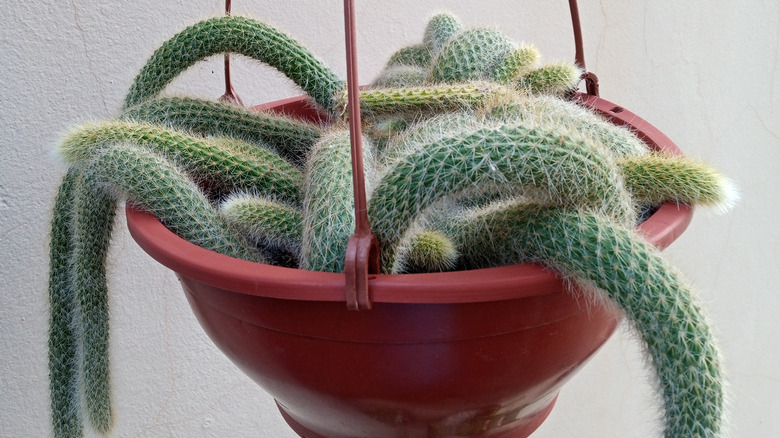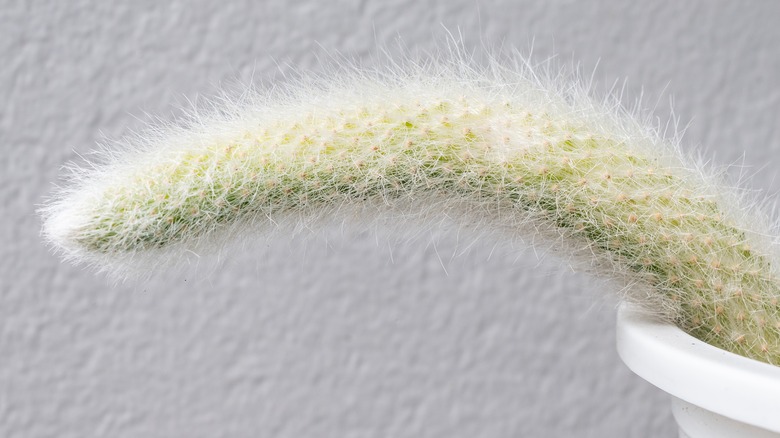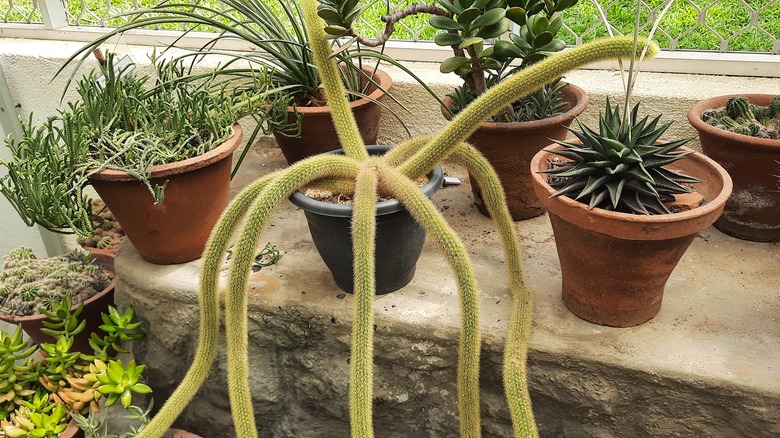The Simple Way To Tell If Your Monkey Tail Cactus Is Getting Enough Light
We may receive a commission on purchases made from links.
Any houseplant collector worth their salt has a monkey tail cactus in their lineup. It's one of those unusual pieces that is just too unique to pass up. It looks exactly as its name suggests: Rather than being upright or bulbous like other cacti, it has long, floppy "tails" covered in soft spines that give it a furry appearance. Because of how interesting it looks, it's a great addition to not only a plant shelf but to your room's overall aesthetic. It becomes something of a decor item. While it packs a visual punch, you can't just stick it in any part of the room. These cacti need plenty of indirect light in order to be happy and healthy. And one easy way to tell that they're not receiving enough sun is by monitoring their color. If it's a bright green, it's situated in a great spot. If it begins to turn a very pale green color, then it's too far away from a light source.
Ideally, these plants should receive constant bright light that is indirect. They can soak up to 14 hours of light, so you want to make sure they're not placed anywhere shadowy or too far away from a window. You will instantly know if they're not getting enough light once they start to change hues. Here is what to know.
Why the cactus will change color
The monkey tail cactus isn't the only plant that will turn a lighter shade of green when it isn't getting sufficient sunlight. In fact, almost all plants will go through the shade shift. That's because they get their bright green, healthy color from photosynthesizing. When they're absorbing enough energy, the chlorophyll that colors their leaves turns bright green. When the plant isn't absorbing enough energy, it's not photosynthesizing enough, and the leaves turn a pale color. It hints at the fact that the chlorophyll isn't working, which means it needs a sunnier area.
Of course, when it comes to your monkey tail cactus color, it depends on which variety you have. Some come in a bright green shade, while others lean more towards a yellow-green shade. When determining if yours has a sufficient amount of light, focus on whether or not the plant turned paler over the last few weeks.
What does bright, indirect light look like
If you notice your cactus becoming lighter, you need to move it to a brighter spot. However, there is a difference between bright, indirect light (which you want) and bright, direct light (which you don't want.) Bright, indirect light usually means light that is filtered in some way, meaning you're not exposing the plant to the full blast of the sun. This can mean placing the plant two feet away from the window pane or filtering the light through a sheer curtain. You should also keep an eye on which way your window is facing. North-facing windows get the least amount of light, so they won't be sufficient to warm your monkey tail cactus, which likes to get around 14 hours of light. East-facing windows get light in the A.M., but then turn weak and dim. South-facing windows get the strongest amount of light, followed by west-facing panes, so situate your plant in front of one of those two.
If you're unsure if your cactus is getting enough light, you can double-check with a light meter. Cacti thrive when they receive 4,000 and 5,000 ftc. "Ftc" is short for "foot candle," which is a measurement of light; it captures how much light a candle can radiate in a single foot. To find the best location for your houseplant, you can use something like the BTMETER Light Lux Meter to test how many ftcs your plant is getting, which you can get for $34 on Amazon.


